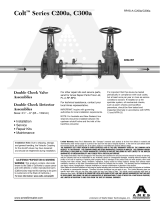
957 OSY
RP/IS-957/957RPDA
Installation, Maintenance, & Repair
Series 957, 957RPDA, LF957RPDA
Reduced Pressure Zone Assemblies
Reduced Pressure Detector Assemblies
Sizes: 2
1
⁄2" – 10"
NOTICE
For Australia and New Zealand: Pipeline strainers should be
installed between the upstream shutoff valve and the inlet of the
backflow preventer.
It's important that this device be tested periodically in compli-
ance with local codes, but at least once per year or more as
service conditions warrant. If installed on a fire sprinkler system,
all mechanical checks, such as alarm checks and backflow
preventers, should be flow tested and inspected internally in ac-
cordance with NFPA 13 and NFPA 25.
Testing
For field testing procedure, refer to Watts installation sheets
IS-TK-DP/DL, IS-TK-9A, IS-TK-99E and IS-TK-99D found on
www.watts.com.
For other repair kits and service parts, refer to our Backflow Pre-
vention Products Repair Kits & Service Parts price list
PL-RP-BPD found on www.watts.com.
For technical assistance, contact your local Watts representative.
WARNING
!
Read this Manual BEFORE using this equipment.
Failure to read and follow all safety and use information
can result in death, serious personal injury, property
damage, or damage to the equipment.
Keep this Manual for future reference.
Guidelines
1. Most field problems occur because dirt and debris are pres-
ent in the system at the time of installation and becomes
trapped in the #1 check. The system should be flushed
before the backflow valve is installed. If the system is not
flushed until after the backflow valve is installed, remove both
check modules from the valve and open the inlet shutoff to
allow water to flow for a sufficient time to flush debris from
the water line. If debris in the water system continues to
cause fouling, a strainer can be installed upstream of the
backflow assembly.
2. Watts Series 957, 957RPDA and LF957RPDA may be in-
stalled in either horizontal, “N” pattern, or “Z” pattern position
as long as the backflow assembly is installed in accordance
with the direction of the flow arrow on the assembly and the
local water authority approves the installation.
3. The assembly should be installed with adequate clearance
around the valve to allow for inspection, testing and servic-
ing. 12" (305mm) should be the minimum clearance between
the lower portion of the assembly and the floor or grade. The
valve should be protected from freezing.
4. Installing a backflow preventer in a pit or vault is not
recommended.
5. Normal discharge and nuisance spitting are accommodated
by the use of a Watts air gap fitting and a fabricated indirect
waste line. A floor drain appropriately sized for the discharge
must be provided in case of excessive discharge. See Watts
document ES-RVD for relief valve discharge rates.
6. The 957, 957RPDA and LF957RPDA backflow preventer
should be tested by a certified tester at the time of installation.
NOTICE
Assembly body should not be painted.
Local building or plumbing codes may require modifica-
tions to the information provided. You are required to
consult the local building and plumbing codes prior
to installation. If the information provided here is not
consistent with local building or plumbing codes, the
local codes should be followed. This product must be
installed by a licensed contractor in accordance with
local codes and ordinances.
WARNING
!
Need for Periodic Inspection/Maintenance: This product
must be tested periodically in compliance with local codes,
but at least once per year or more as service conditions
warrant. All products must be retested once maintenance
has been performed. Corrosive water conditions and/or
unauthorized adjustments or repair could render the product
ineffective for the service intended. Regular checking and
cleaning of the product’s internal and external components
helps assure maximum life and proper product function.
WARNING
!






